Numerical Simulation Analyses on Envelope Structures of Economic Passive Buildings in Severe Cold Region
Abstract
1. Introduction
2. Passive Building Case
2.1. Climate Analyses on Severe Cold Region of China
2.2. Energy-Saving Measures of Passive Building
3. Computational Methodology and Physical Model
3.1. Computational Methodology
3.2. Passive Building Physical Model
3.3. Validation for Simulation Method
4. Results and Discussion
4.1. Energy Consumption Characteristics
4.2. Energy Consumption of Non-Transparent Envelope Structure
4.2.1. Energy Consumption of Exterior Wall
4.2.2. Energy Consumption of Building Roof
4.2.3. Energy Consumption of Floor Decking and Interior Walls
4.3. Energy Consumption of Exterior Windows
4.3.1. Heat Transfer Coefficients of Exterior Windows
4.3.2. Window-to-Wall Ratio
5. Conclusions
Author Contributions
Funding
Institutional Review Board Statement
Informed Consent Statement
Data Availability Statement
Conflicts of Interest
References
- Mukhopadhyaya, P.; MacLean, D.; Korn, J.; van Reenen, D.; Molleti, S. Building application and thermal performance of vacuum insulation panels (VIPs) in Canadian subarctic climate. Energy Build. 2014, 85, 672–680. [Google Scholar] [CrossRef]
- Orsini, F.; Marrone, P.; Asdrubali, F.; Roncone, M.; Grazieschi, G. Aerogel insulation in building energy retrofit. Performance testing and cost analysis on a case study in Rome. Energy Rep. 2020, 6, 56–61. [Google Scholar] [CrossRef]
- Čekon, M.; Čurpek, J.; Slávik, R.; Šikula, O. Coupled transparent insulation system with low emissivity solar absorber: An experimentally validated building energy simulation study. Sci. Technol. Built Environ. 2020, 26, 511–523. [Google Scholar] [CrossRef]
- Shameri, M.A.; Alghoul, M.A.; Elayeb, O.; Zain, M.F.M.; Alrubaih, M.S.; Amir, H.; Sopian, K. Daylighting characterstics of existing double-skin façade office buildings. Energy Build. 2013, 59, 279–286. [Google Scholar] [CrossRef]
- Liu, Z.; Yu, Z.; Yang, T.; Qin, D.; Li, S.; Zhang, G.; Haghighat, F.; Joybari, M.M. A review on macro-encapsulated phase change material for building envelope applications. Build. Environ. 2018, 144, 281–294. [Google Scholar] [CrossRef]
- da Cunha, S.R.L.; de Aguiar, J.L.B. Phase change materials and energy efficiency of buildings: A review of knowledge. J. Energy Storage 2020, 27, 101083. [Google Scholar] [CrossRef]
- Lachheb, M.; Younsi, Z.; Naji, H.; Karkri, M.; Nasrallah, S.B. Thermal behavior of a hybrid PCM/plaster: A numerical and experimental investigation. Appl. Therm. Eng. 2017, 111, 49–59. [Google Scholar] [CrossRef]
- Cui, Y.; Xie, J.; Liu, J.; Pan, S. Review of Phase Change Materials Integrated in Building Walls for Energy Saving. Procedia Eng. 2015, 121, 763–770. [Google Scholar] [CrossRef]
- Ibrahim, M.; Bianco, L.; Ibrahim, O.; Wurtz, E. Low-emissivity coating coupled with aerogel-based plaster for walls’ internal surface application in buildings: Energy saving potential based on thermal comfort assessment. J. Build. Eng. 2018, 18, 454–466. [Google Scholar] [CrossRef]
- Somasundaram, S.; Thangavelu, S.R.; Chong, A. Improving building efficiency using low-e coating based retrofit double glazing with solar films. Appl. Therm. Eng. 2020, 171, 115064. [Google Scholar] [CrossRef]
- Shao, T.; Zheng, W.; Cheng, Z. Passive Energy-Saving Optimal Design for Rural Residences of Hanzhong Region in Northwest China Based on Performance Simulation and Optimization Algorithm. Buildings 2021, 11, 421. [Google Scholar] [CrossRef]
- Zhang, T.; Wang, D.; Hui, L.; Wu, H. Numerical investigation on building envelope optimization for low-energy buildings in low latitudes of China. Build. Simul. 2020, 13, 257–269. [Google Scholar] [CrossRef]
- Sadineni, S.B.; Madala, S.; Boehm, R.F. Passive building energy savings: A review of building envelope components. Renew. Sustain. Energy Rev. 2011, 15, 3617–3631. [Google Scholar] [CrossRef]
- Younes, C.; Shdid, C.A. A methodology for 3-D multiphysics CFD simulation of air leakage in building envelopes. Energy Build. 2013, 65, 146–158. [Google Scholar] [CrossRef]
- Yang, J.; Wu, H.; Xu, X.; Huang, G.; Xu, T.; Guo, S.; Liang, Y. Numerical and experimental study on the thermal performance of aerogel insulating panels for building energy efficiency. Renew. Energy 2019, 138, 445–457. [Google Scholar] [CrossRef]
- Koç, S.G.; Kalfa, S.M. The effects of shading devices on office building energy performance in Mediterranean climate regions. J. Build. Eng. 2021, 44, 102653. [Google Scholar] [CrossRef]
- Tzempelikos, A.; Athienitis, A.K. The impact of shading design and control on building cooling and lighting demand. Sol. Energy 2007, 81, 369–382. [Google Scholar] [CrossRef]
- Mohammed, A.; Tariq, M.A.U.R.; Ng, A.W.M.; Zaheer, Z.; Sadeq, S.; Mohammed, M.; Mehdizadeh-Rad, H. Reducing the Cooling Loads of Buildings Using Shading Devices: A Case Study in Darwin. Sustainability 2022, 14, 3775. [Google Scholar] [CrossRef]
- Xing, Q.; Hao, X.; Lin, Y.; Tan, H.; Yang, K. Experimental investigation on the thermal performance of a vertical greening system with green roof in wet and cold climates during winter. Energy Build. 2019, 183, 105–117. [Google Scholar] [CrossRef]
- He, G.; Shu, L.; Zhang, S. Double skin facades in the hot summer and cold winter zone in China: Cavity open or closed? Build. Simul. 2011, 4, 283–291. [Google Scholar] [CrossRef]
- Preet, S.; Sharma, M.K.; Mathur, J.; Chowdhury, A.; Mathur, S. Performance evaluation of photovoltaic double-skin facade with forced ventilation in the composite climate. J. Build. Eng. 2020, 32, 101733. [Google Scholar] [CrossRef]
- Hamdy, M.; Mauro, G.M. Optimizing Hybrid Ventilation Control Strategies Toward Zero-Cooling Energy Building. Front. Built Environ. 2019, 5, 97. [Google Scholar] [CrossRef]
- Bhamare, D.K.; Rathod, M.K.; Banerjee, J. Passive cooling techniques for building and their applicability in different climatic zones—The state of art. Energy Build. 2019, 198, 467–490. [Google Scholar] [CrossRef]
- Aridi, R.; Yehya, A. Review on the sustainability of phase-change materials used in buildings. Energy Convers. Manag. X 2022, 15, 100237. [Google Scholar] [CrossRef]
- Sawadogo, M.; Duquesne, M.; Belarbi, R.; Hamami, A.E.A.; Godin, A. Review on the Integration of Phase Change Materials in Building Envelopes for Passive Latent Heat Storage. Appl. Sci. 2021, 11, 9305. [Google Scholar] [CrossRef]
- Chua, K.J.; Chou, S.K. Evaluating the performance of shading devices and glazing types to promote energy efficiency of residential buildings. Build. Simul. 2010, 3, 181–194. [Google Scholar] [CrossRef]
- Chi, F.; Xu, Y.; Pan, J. Impact of shading systems with various type-number configuration combinations on energy consumption in traditional dwelling (China). Energy 2022, 255, 124520. [Google Scholar] [CrossRef]
- Al-Saadi, S.N.; Al-Jabri, K.S. Optimization of envelope design for housing in hot climates using a genetic algorithm (GA) computational approach. J. Build. Eng. 2020, 32, 101712. [Google Scholar] [CrossRef]
- Yang, S.; Su, H.; Dou, X.; Chen, M.; Huang, Y. Heat Balance Calculation and Energy Efficiency Analysis for Building Clusters Based on Psychrometric Chart. Sensors 2021, 21, 7606. [Google Scholar] [CrossRef]
- Feng, G.H.; Wang, Y.; Xu, X.L.; Wang, K.R. Analysis of Measured Results of Energy Consumption for the Nearly Zero Energy Building in Severe Cold Area. J. Build. Energy Effic. 2019, 47, 1–5. [Google Scholar]
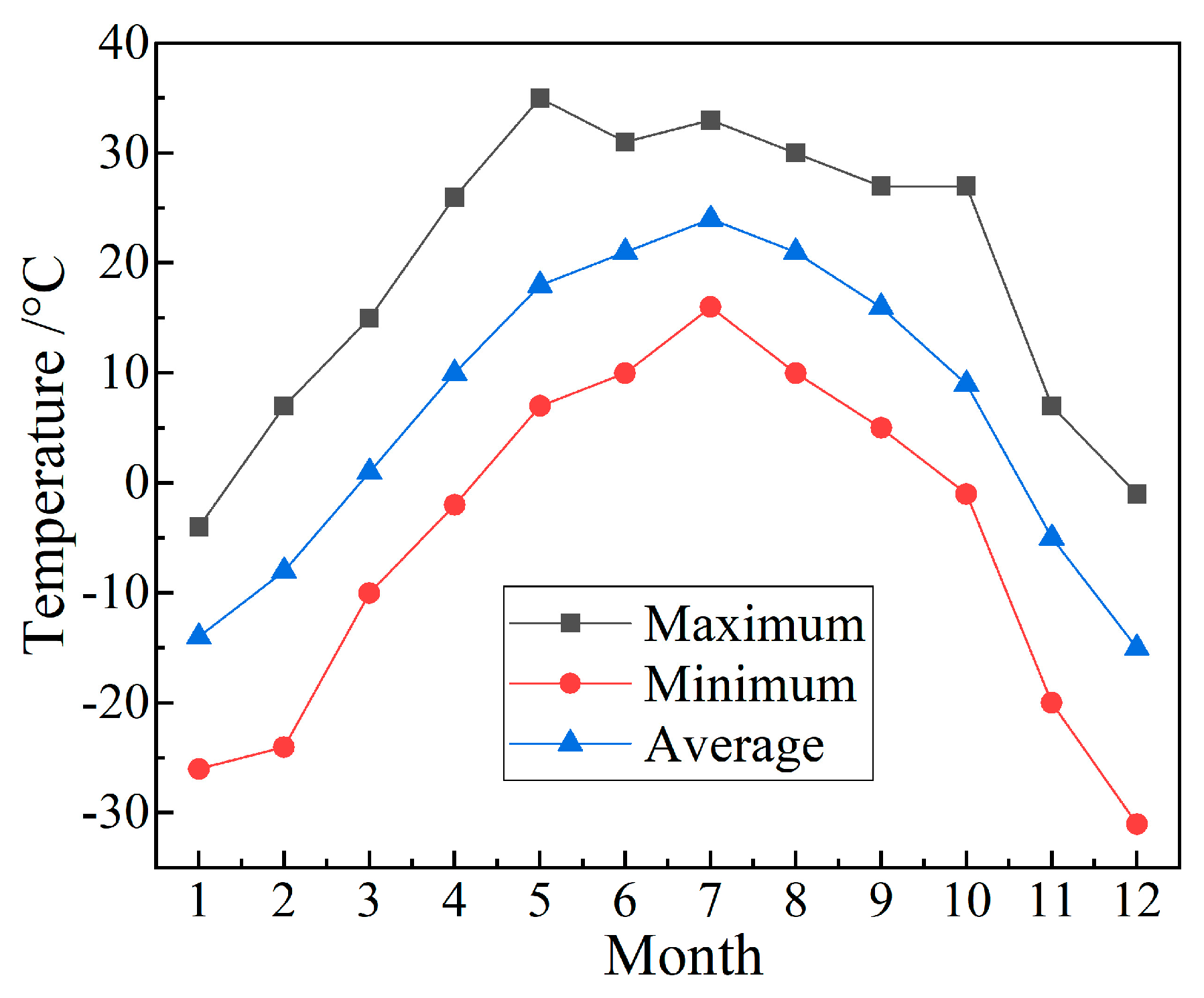



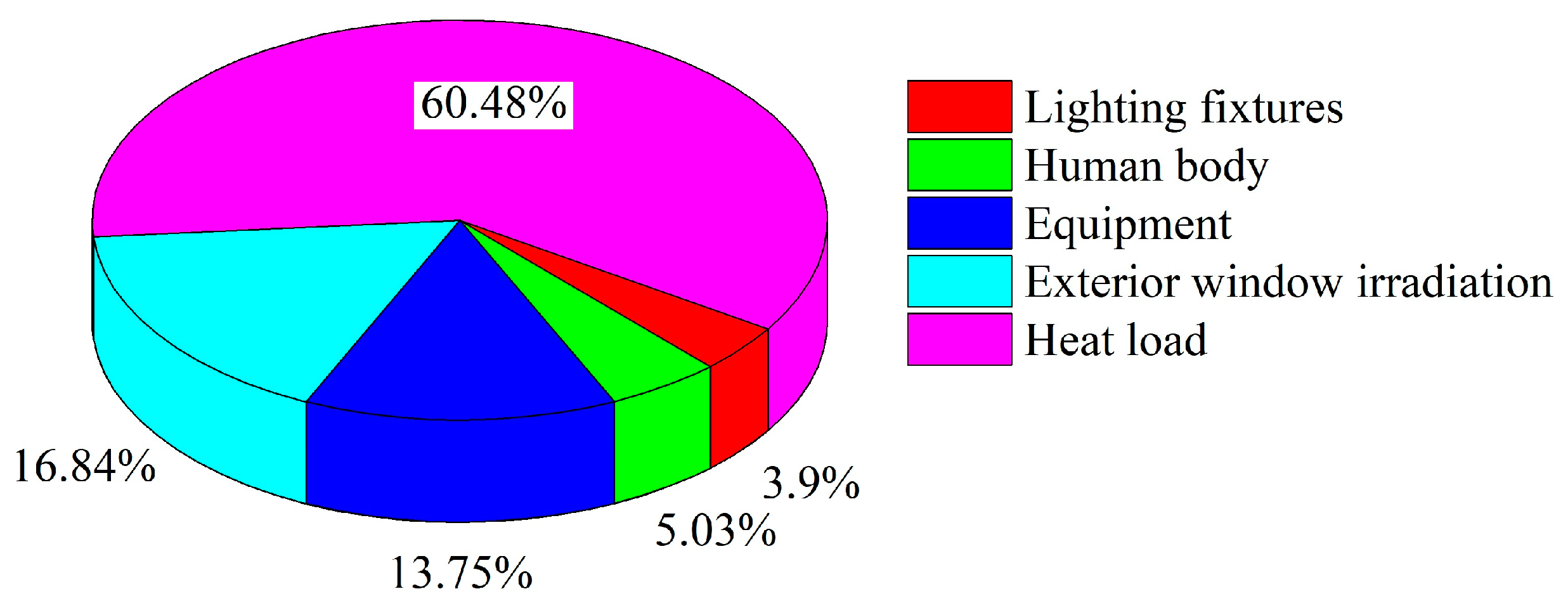
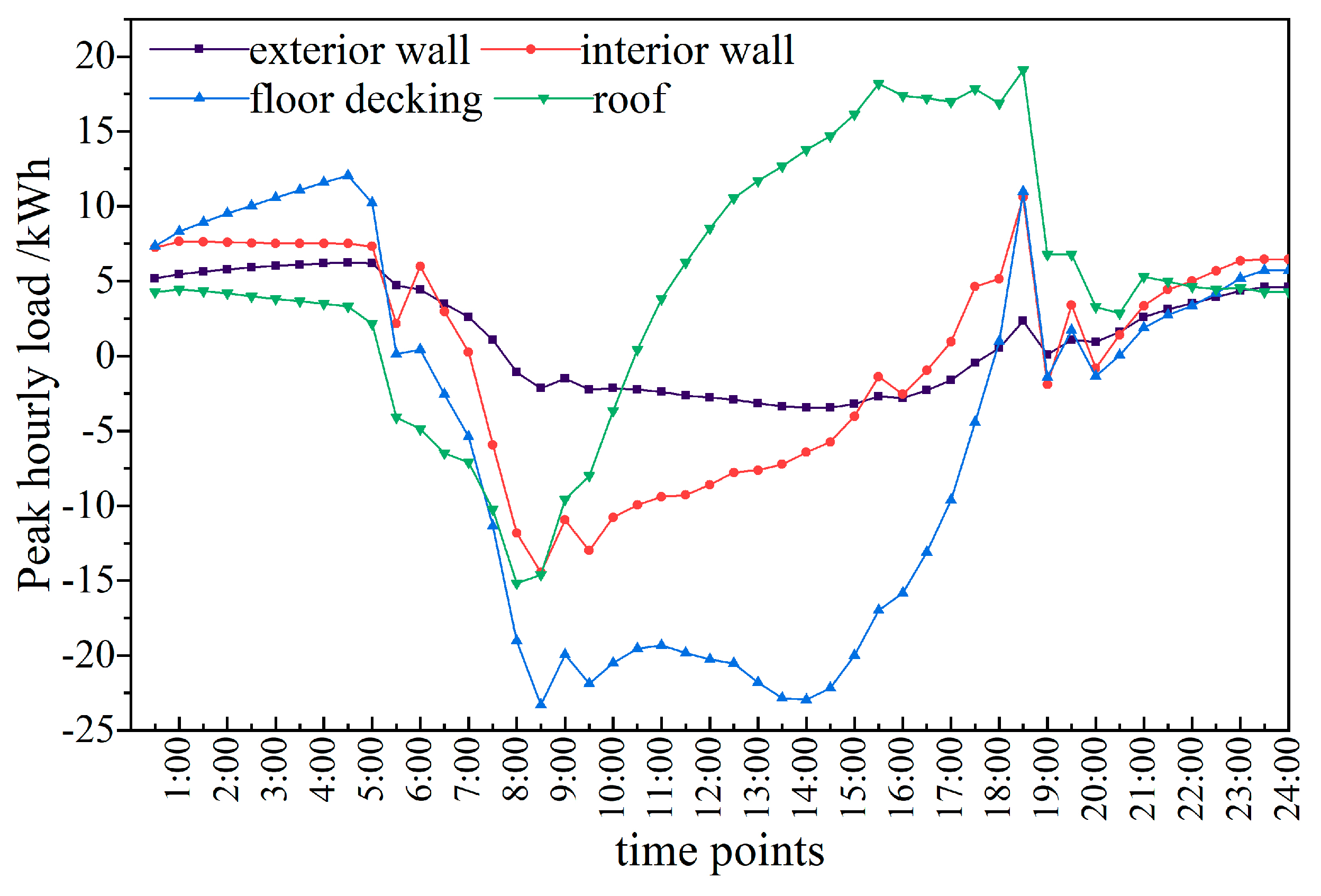
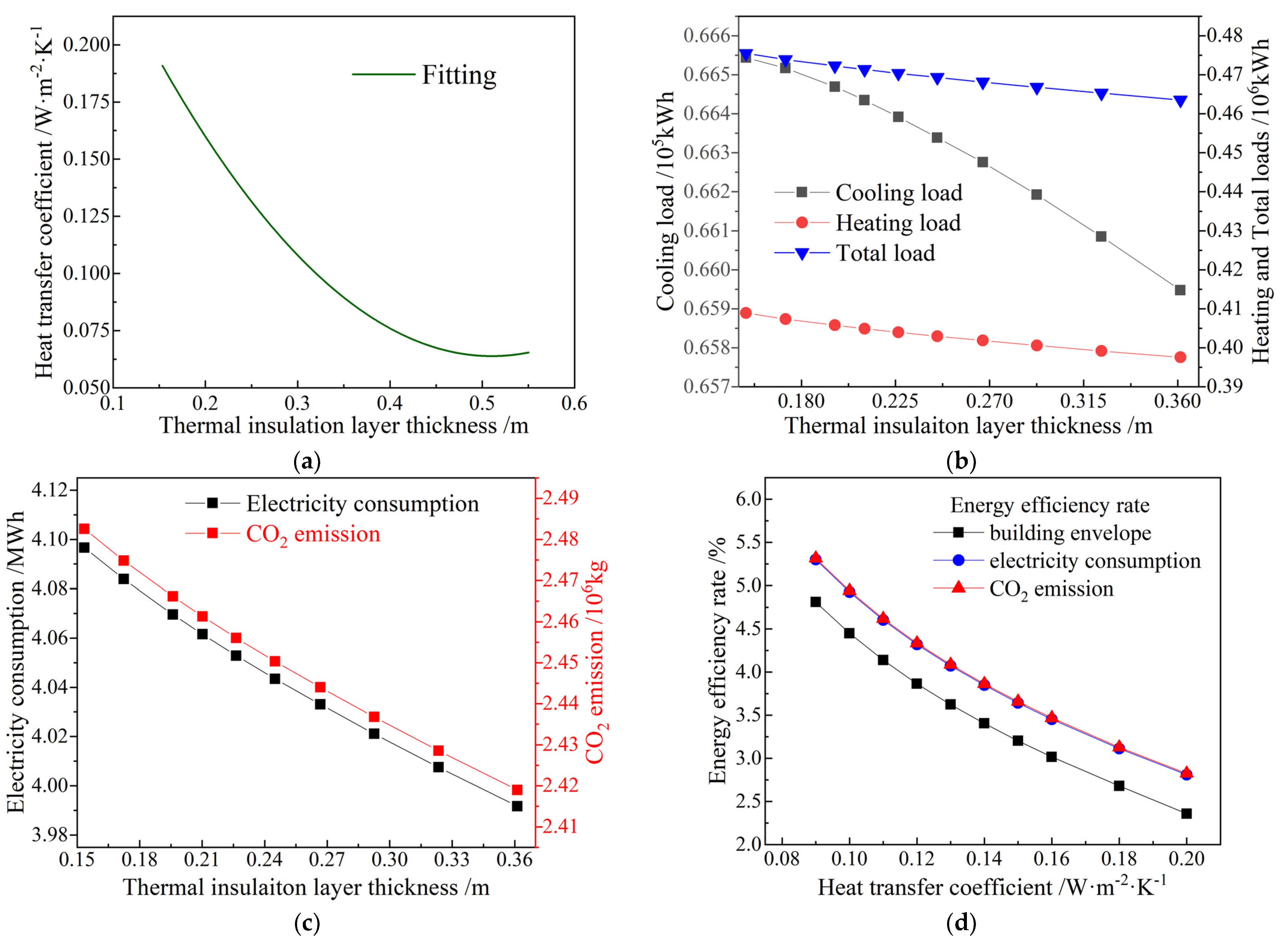
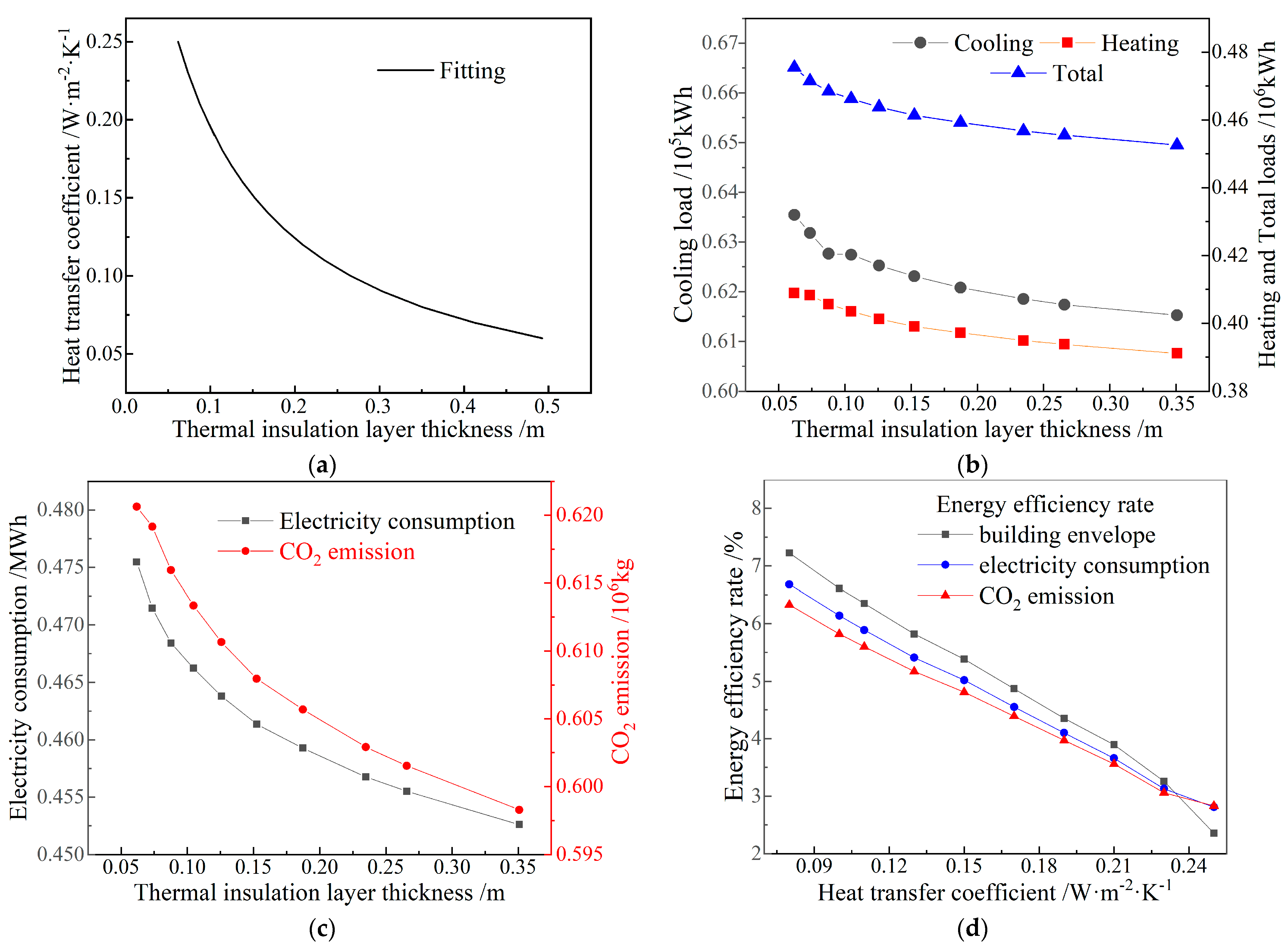

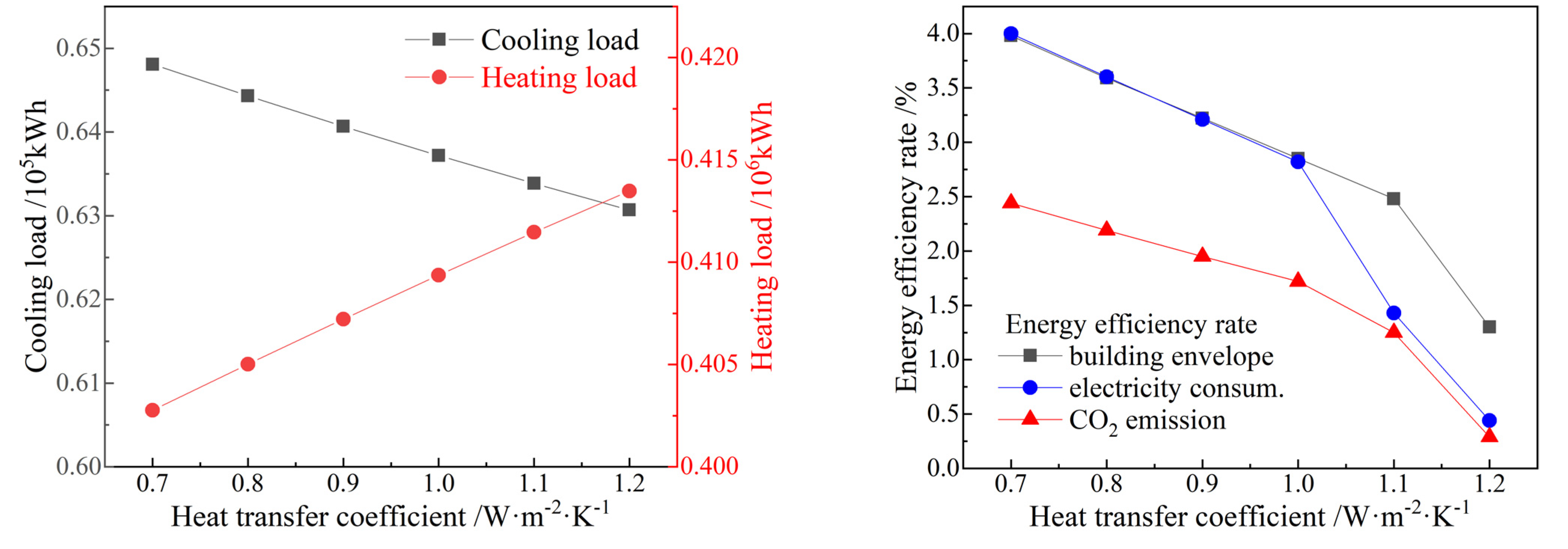


| Functional Division | Built-Up Area/m2 | Functional Region | Built-Up Area/m2 |
|---|---|---|---|
| First-floor exhibition hall | 600 | Staff canteen | 250 |
| Large office | 110 | Restroom | 63 |
| Small office | 30 | Second-floor conference room | 260 |
| Reception room | 20 | Second-floor office | 70 |
| Season | Temperature during Working Hours/°C | Temperature during Non-Working Hours/°C | Relative Humidity /% |
|---|---|---|---|
| Summer | 26 | 30 | 40~65 |
| Winter | 20 | 15 |
| Parameter | Lighting Power/W·m−2 | Per Capita Occupied Area/m2·p−1 | Per Capita Fresh Air Volume/m3·h−1·p−1 | Electrical Equipment Power/W·m−2 | Human Metabolic Rate/W·p−1 |
|---|---|---|---|---|---|
| Value | 3 | 32 | 30 | 15 | 0.9 |
| Building Envelope Structure | Exterior Wall | Roof | Floor | Interior Wall | Exterior Window | Exterior Door |
|---|---|---|---|---|---|---|
| K/W·m−2·K−1 | 0.2 | 0.25 | 0.3 | 1.2 | 1.2 | 1.5 |
| Indoor Temperature/°C | Power Consumption/kW·h | |||
|---|---|---|---|---|
| Summer | Winter | Summer | Winter | |
| Simulation | 24.75 | 22.42 | 46.37 | 63.58 |
| Measurement | 26.09 | 24.34 | 52.41 | 72.24 |
| Building Performance Indicators | Cooling Season | Heating Season |
|---|---|---|
| cumulative load/kWh | 68,137.95 | 418,808.38 |
| cumulative load per unit area/kWh·m−2 | 13.55 | 83.34 |
| peak load/W | 45,747.56 | 168,892.77 |
| peak load per unit area/W·m−2 | 9.10 | 33.60 |
| peak load time | Aug-09-14:00 | Jan-23-12:30 |
| outdoor temperature at peak load/°C | 33.10 | −22.7 |
| Peak power consumption/W | 175,942.45 | |
| annual power consumption per unit area/kWh·m−2 | 12.80 | |
| CO2 emission/kg | 836,130.4 | |
| Material | Heat Transfer Coefficient/W·m−2·K−1 | Heat Capacity/J·kg−1·K−1 | Density/kg·m−3 |
|---|---|---|---|
| Brick (100 mm) | 0.84 | 800 | 1700 |
| Extruded polystyrene foam board (XPS) | 0.034 | 1400 | 35 |
| Concrete block (100 mm) | 0.51 | 1000 | 1409 |
| Material | Heat Transfer Coefficient/W·m−2·K−1 | Heat Capacity/J·kg−1·K−1 | Density/kg·m−3 |
|---|---|---|---|
| Asphalt (0.01 m) | 0.7 | 1000 | 2100 |
| Fiberglass (0.05 m) | 0.035 | 1400 | 25 |
| Gypsum board (0.15 m) | 0.25 | 896.3 | 2800 |
Disclaimer/Publisher’s Note: The statements, opinions and data contained in all publications are solely those of the individual author(s) and contributor(s) and not of MDPI and/or the editor(s). MDPI and/or the editor(s) disclaim responsibility for any injury to people or property resulting from any ideas, methods, instructions or products referred to in the content. |
© 2023 by the authors. Licensee MDPI, Basel, Switzerland. This article is an open access article distributed under the terms and conditions of the Creative Commons Attribution (CC BY) license (https://creativecommons.org/licenses/by/4.0/).
Share and Cite
Liu, C.; Sun, C.; Li, G.; Yang, W.; Wang, F. Numerical Simulation Analyses on Envelope Structures of Economic Passive Buildings in Severe Cold Region. Buildings 2023, 13, 1098. https://doi.org/10.3390/buildings13041098
Liu C, Sun C, Li G, Yang W, Wang F. Numerical Simulation Analyses on Envelope Structures of Economic Passive Buildings in Severe Cold Region. Buildings. 2023; 13(4):1098. https://doi.org/10.3390/buildings13041098
Chicago/Turabian StyleLiu, Chao, Chunhai Sun, Guangyuan Li, Wenjia Yang, and Fang Wang. 2023. "Numerical Simulation Analyses on Envelope Structures of Economic Passive Buildings in Severe Cold Region" Buildings 13, no. 4: 1098. https://doi.org/10.3390/buildings13041098
APA StyleLiu, C., Sun, C., Li, G., Yang, W., & Wang, F. (2023). Numerical Simulation Analyses on Envelope Structures of Economic Passive Buildings in Severe Cold Region. Buildings, 13(4), 1098. https://doi.org/10.3390/buildings13041098





